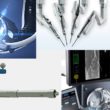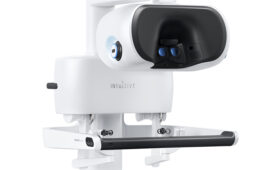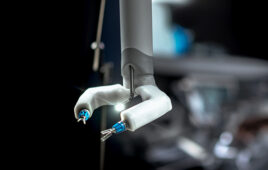
Robot aligned with entry trajectory on phantom head. [Image from ARTORG Center for Biomedical Engineering Research, University of Bern]
A cochlear implant is an electronic device that helps people hear again, but it does not restore hearing. There is an external portion that sits outside of the ear and a second part that is surgically implanted under the skin. The implant has a microphone, speech processor, transmitter and receiver/stimulator and an electrode array. A cochlear implant is not the same as a hearing aid. A hearing aid amplifies sound while a cochlear implant bypasses damaged portions of the ear to directly stimulate the auditory nerve.
There are approximately 324,200 registered cochlear implants that have been implanted globally, according to the National Institute on Deafness and Other Communication Disorders.
To implant a cochlear implant, surgeons usually have to create an access point behind the ear through the skull. Then an electrode that bridges the damaged part of the inner ear to restore hearing is put into the cochlea through the access point – all of which is done manually.
The researchers noticed that using surgical planning software and a robotic drill created a tunnel that was about 2.5 mm in diameter and allowed a straight line, direct access to the cochlea. The hole is considered minimally-invasive, according to the researchers, and leaves a safe distance between the facial nerve and the chorda tympani nerve into the cochlea for the implant.
Using three interlocking safety components, the drill can be safely navigated inside the human ear and avoids damage to nerves and microscopic structures. After having gone through rigorous technical and laboratory testing stages to make sure it was going to be safe for patients, the robot was able to be moved from the laboratory to an operating room.
“The robot relies on a number of sensors which are a high-accuracy, optical tracking system, a sensor for resistance that can ‘feel’ the texture of the bone while drilling, and a radar-like nerve stimulation probe that sends small electric pulses into the bone from which the robot can compute whether or not it is on the preplanned track,” said Stefan Weber, a member of the ARTORG Center for Biomedical Engineering Research, in a press release.
The surgeon knows where the robot is at all times and can control the drill safely.
“Our results encourage us that we have addressed many of the challenges of using a robot for cochlear implantation surgery,” said Marco Caversaccio, a member of the Department of ORL, Head and Neck Surgery at Inselspital in Bern.
The researchers suggest that the robot operates in the same way that avionics allows a plane to fly where instruments are controlled by read outs from the cockpit. The robot can perform procedures that a surgeon can’t do without the help of a robot. They hope to further develop the robot for drug delivery into the inner ear.
[Want to stay more on top of MDO content? Subscribe to our weekly e-newsletter.]






